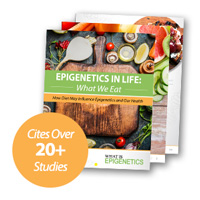
There has been growing literature that suggests how environmental chemical exposure can lead to birth defects but the majority of the studies are association based. A fraction of those studies have shown how ambient chemical exposure affects insulin sensitivity and lipid metabolism1 or affecting gut-microbiota2. But how early life chemical exposure can affect epigenetics—or change the epigenome and drive the effect till later life was missing.
A new study published recently in Nature Communication by Dr. Lindsey Treviño and her team sheds light on such possible epigenetic mechanisms3. The authors pinpoint the molecular mechanisms of how environmental chemical exposure can affect key histone modifications early in life without disrupting the corresponding gene transcriptions in the liver, but later life diet-dependent metabolic disruption aggravating the harmful impacts.
The authors especially looked at endocrine-disrupting chemicals (EDCs), which are chemicals leaching predominantly from reusable household plastic utensils, that interfere with endocrine/hormonal system, leading to birth defects, tumors, or developmental disorders.
To understand the early effects of EDC exposure in liver development and maturation into the adult stage, the authors exposed bisphenol A (BPA), a typical EDC found in plastic bottles, to neonatal rats and profiled liver histone modifications, and transcriptomes in a longitudinal manner. After exposure to BPA at the neonatal stage, the rats were allowed to grow into adults. At day 70(around 2 months), the rats did not show any apparent phenotypic abnormalities. But at 240 days (8 months) of age, a “second hit” was giving to challenge their metabolism with the western diet, which typically contains high fat, fructose, and cholesterol.
Compared to the age-matched controls, the EDC exposed, the western diet-fed rats had visible liver damage by enlarged liver and size with no increase of body weight. Molecular marker of liver damage, serum alanine aminotransferase (ALT) was also increased. As the liver failed to support lipid metabolism due to EDC exposer in the neonates, they developed dyslipidemia.
The unbiased lipidomic analysis revealed upregulated serum lipid types e.g. phospholipids, triglycerides, cholesterol esters, etc. This effect was specific to the liver as all the other global metabolic parameters, such as bile acid levels, glucose, plasma insulin, or circulating FGF21 was not changed between BPA vs vehicle-treated neonates that became adults.
As the authors speculated that early epigenome changes could lead to this metabolic dysregulation in later life, they focused on studying cis-regulatory histone modifications that could confer this effect, namely, gene promoter histone modifications (activating H3K4me3, repressing H3K27me3 mark) and enhancer histone marks (H3K4me1 and H3K27ac). Except for H3K4me3, all the other three histone marks showed EDC-related epigenome remodeling corresponding to accelerated aging.
These modifications reprogrammed epigenomes at the promoter and enhancer silently (without affecting the corresponding gene expression) and persisted for a long time, unless it was exposed to later life adverse diet, challenging the metabolic system.
One of the crucial genes that underwent this reprogramming was Egr1(Early Growth Response 1), which regulates liver metabolism. From postnatal to adult age, H3K4me1 usually increases at the promoter of this gene, but EDC exposer leads to aggravated H3K4me1 deposition.
To find out how EDC-induced reprogrammed epigenome, challenged by western diet, affected gene expression in the liver at adult stages, the authors preformed an RNA-seq and found that majority of the deregulated genes are from metabolic pathways, such as cholesterol, fatty acid, and xenobiotic metabolism. Gene ontology (GO) enrichment analysis showed that those genes were part of hormone response elements which were evident as early as 70 days old rats.
As expected, as permissive promoter histone marks were enriched for Egr1 due to early EDC exposer and subsequent western diet, its mRNA and protein expression was also significantly increased. Egr1 is a crucial transcription factor that controls genes related to liver metabolism. Early EDC exposer without western diet only changed the epigenetic marks silently, without affecting its transcription. Only when EDC exposed rats were fed with the western diet, the expression was increased. Later analysis revealed that more than 60% of the genes deregulated were direct targets of Egr1.
Therefore, Egr1 expression due to EDC and western diet subsequently started a cascade of gene expression. The authors then investigated metabolome changes in the liver by EDC and western diet-fed rats. Targeted metabolomics confirmed this gene expression changes corresponding to one-carbon, lipid, and cholesterol metabolic pathway related metabolites.
As concluding remarks, the authors successfully demonstrated how early life EDC exposer could be an understudied phenomenon that can put individuals at metabolic disease risk by being exposed to overnutrition, namely the western diet. While male rats were greatly affected than females, this strengthens the support for more gender-inclusive health research and further epidemiological studies. Moreover, the authors provide concrete proof of how silently reprogrammed epigenome can be transcriptionally activated due to the environment: epigenome interactions.
1. Li, R. et. al. (2020). Sex-dependent effects of ambient PM 2.5 pollution on insulin sensitivity and hepatic lipid metabolism in mice. Particle and Fibre toxicology 17.1-14.
2. Qiao, R. et. al. (2019) Accumulation of different shapes of microplastics initiates intestinal injury and gut microbiota dysbiosis in the gut of zebrafish. Chemosphere 236. 124334.
3. Treviño, L.S. et. al. (2020). Epigenome environment interactions accelerate epigenomic aging and unlock metabolically restricted epigenetic reprogramming in adulthood. Nature Communications 11(1). 1-14.


